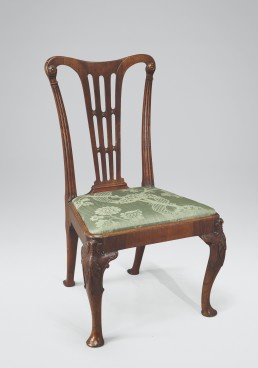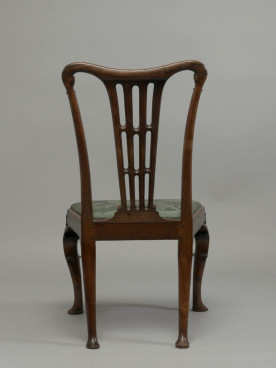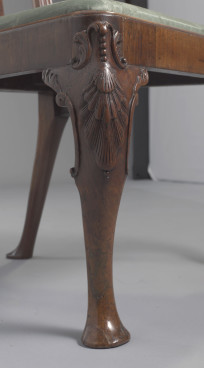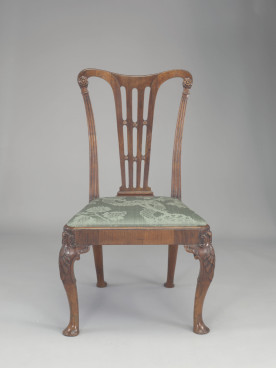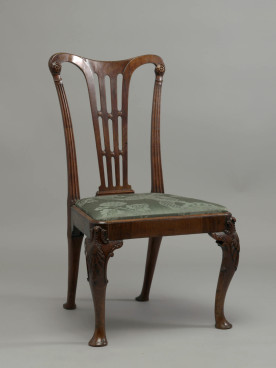Chair, c.1740–50
Walnut, now with 18th-century silk damask
The back has a rosette-tied fan splat. This chair is one of a pair from a larger set.
Adam Bowett Catalogue (19/08/2012)
Description
A pair of walnut chairs, c.1745. The backs have rosette-tied fan splats rising to an outward-scrolling crest rail, between splayed fluted uprights, the needlework slip seat is raised on shell and leaf carved cabriole fore legs with pad feet and plain tapered back legs with backward-pointing pad feet.
Dimensions
H: 39 ½ “ (100cm) Seat height: 17” (43cm) W: 23” (59cm) D: 24“ (61cm)
Materials
Walnut, beech
Dating criteria
So called ‘fan-back’ chairs were introduced about 1740 and were still popular in the 1770s, but the leg design with its late baroque motifs suggests a relatively early date, c.1745.
Construction
All elements of the chair are walnut except for the corner blocks which are beech. The back legs and posts are in one piece and tenoned into the crest rail. The splat is tenoned into the crest rail and the shoe. The back seat rail is tenoned into the rear posts and double pegged. The front faces of the back posts, splat and the crest rail are faced with figured walnut, and the top edge of the crest rail is capped with sections of short grain walnut moulding. The flutes on the back posts are cut into the facing but not the solid timber beneath. The rosettes at the top of the posts are applied on top of the veneer. All seat rails are walnut, faced on the outside with cross-grained veneers; the rails are deeply rebated to accept the seat and finished with a cross-grained ovolo moulding. The seat rails are tenoned into the back posts and double pegged; added depth to the joint is provided by shaped walnut blocks below the rails which are veneered en suite with the rail. At the front the rails are tenoned into the tops of the front legs. The front legs are supported by carved brackets which are reinforced behind with glued walnut blocks. All four corners have triangular beech wood blocks nailed in place – these are conceivably original or early repairs
Marks or stamps
18.1 – marked VII the inside of the back rail. 18.2 – marked XII on inside of back rail.
Condition
18.1- The chair appears to be wholly original, with the possible exception of the triangular corner blocks. There are repairs to the junction of the left back post and crest rail and some stress fractures to the veneers on the splat. All pegs appear to be original. There is historic worm damage to all four seat rails, both back feet have been damaged and repaired; the right back foot is missing part of its inner face. There has been movement in the joints to both front legs, now repaired, some worm damage to left front foot.
18.2 – Repaired breaks to crest rail at the junction with both right and left rear posts; repaired break due to worm damage in the centre of the splat. Considerable worm damage in several parts of the chair. Repairs to both back feet, repairs to joints of both front legs. Right leg has a number of splits, possibly due to timber shakes exacerbated by worm damage, front left leg ditto.
References
For fan back chairs, see Adam Bowett, Early Georgian Furniture, 1715-1740, Woodbridge (2009), pp. 196-198.
Provenance
Purchased form Victor Needham June 1978. Sold one of set of three Christie’s New York 2nd February 1991, Lot 198

